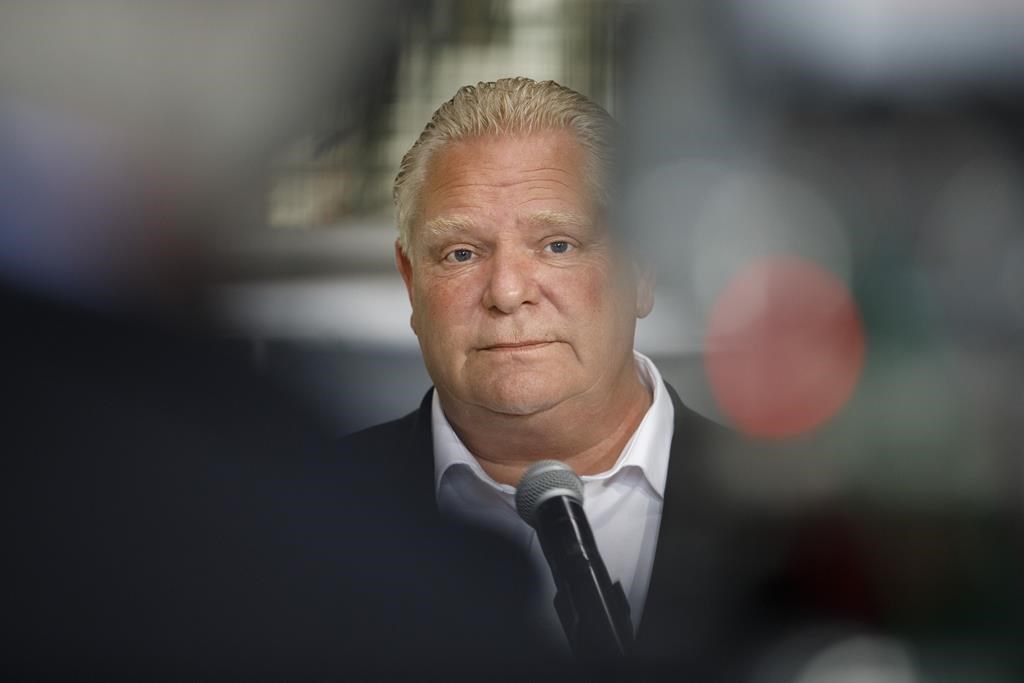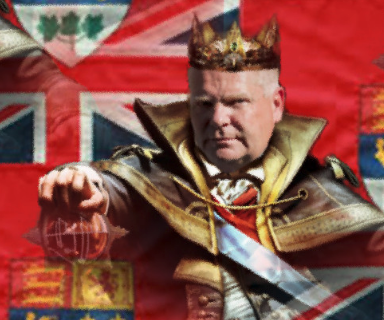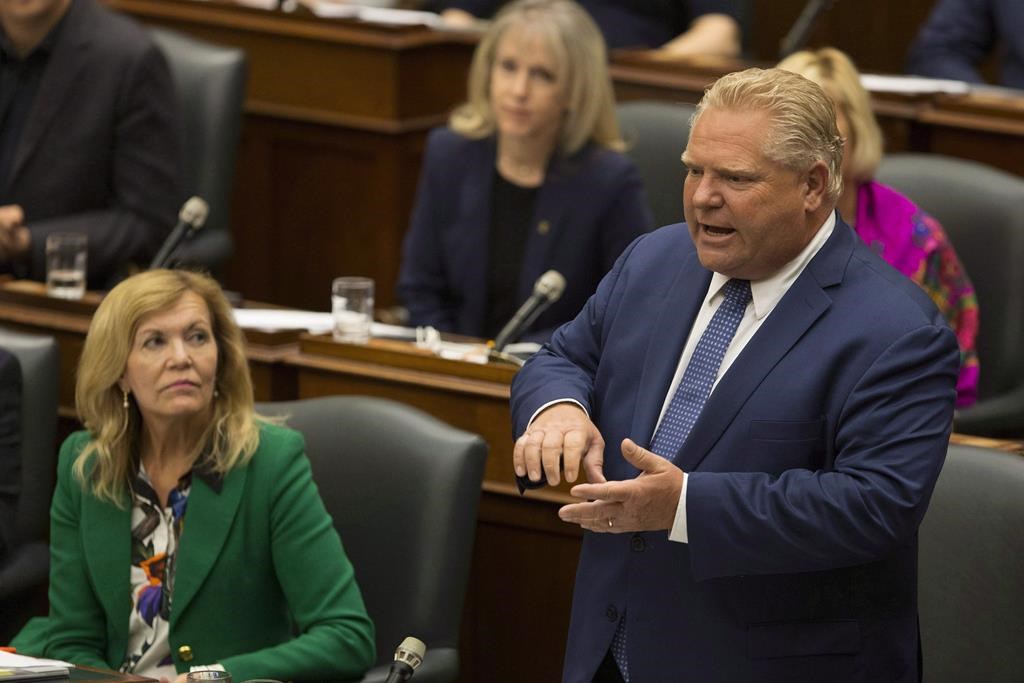This content is restricted to subscribers

The views, opinions and positions expressed by columnists and contributors are the author’s alone. They do not inherently or expressly reflect the views, opinions and/or positions of our publication.

This content is restricted to subscribers
The views, opinions and positions expressed by columnists and contributors are the author’s alone. They do not inherently or expressly reflect the views, opinions and/or positions of our publication.

Become a subscriber today!
Register
Become a subscriber today!
Register
Become a subscriber today!
Register
Become a subscriber today!
Register
When Ontario Premier Doug Ford was running for office, he promised to deliver tax relief for Ontario families and businesses.
“We have a very simple theory,” said Ford during the 2018 provincial election campaign. “Put money back into the taxpayers’ pocket instead of the government’s pocket, because we believe that the taxpayers are a lot smarter at spending their money than any government.”
If that’s really how Ford feels, he has a strange way of showing it.
Taxpayers were promised that the second income tax bracket would be reduced by 20 per cent.
Three years later, an income tax cut is nowhere in sight.
Ford also pledged to deliver relief for drivers at the pumps.
While Ford did repeal the previous government’s cap-and-trade carbon tax scheme which lowered gas prices by 4.3 cents per litre, the Progressive Conservative government has yet to reduce the gas excise tax by 5.7 cents per litre, as promised.
For months, Ford has told taxpayers a gas tax cut is coming. But, according to the premier, Ontarians will have to wait up to another four months to get it.
With near-record-high prices at the pumps, Ontarians need relief now. It’s time for Ford to end his political posturing and finally deliver relief for hardworking families.
During the 2018 election campaign, Ford also promised to cut corporate taxes.
Reducing the corporate tax rate from 11.5 to 10.5 per cent would “enable businesses to create good paying jobs and attract businesses back to Ontario,” said Ford in 2018.
Ontario needs to attract businesses now more than ever. Nearly two years into the pandemic, Ontario has yet to fully recover its lost private sector jobs. Government jobs, on other hand, are up to the tune of tens of thousands.
If Ford truly believes in cutting business taxes to help spur economic growth and job creation, he should do it.
The income, gas, and corporate tax cuts were the three central pillars of the Progressive Conservative plan for tax relief in 2018. In terms of delivering on those priorities, Ford is zero for three.
A little more than six months from now, Ford will be asking Ontario voters to hand him the keys to Queen’s Park for another four years.
Ford has crisscrossed the province in recent months claiming “promises made, promises kept” as he makes billions of dollars in pre-election spending announcements.
But Ford seems to keep his promises only when it comes to spending tax dollars.
He has failed time and again to reduce the tax burden for hardworking Ontarians. While Ford keeps telling taxpayers that the government is the “worst place you can hand your money over” to, he’s spending taxpayer dollars at a record pace.
The government’s fall economic update showed that spending is going up in literally every sector of government.
Three years into his four-year term, Ford is proving himself to be a free-spending premier of historic proportions.
He’s saying yes to spending and no to tax cuts.
Since the 2018 election, Ontario’s provincial debt has exploded by over $30 billion. That includes more than $5 billion of new debt before the pandemic ever hit Ontario’s shores.
Ford promised to fight for taxpayers, but the province already spending more than $1 billion per month paying interest on the provincial debt. He’s actually taking money out of the wallets of future generations.
Ontarians elected Ford three years ago to cut their taxes. It’s time for Ford to do the job he was sent to Queen’s Park to do.
Jay Goldberg is the Ontario Director at the Canadian Taxpayers Federation
The views, opinions and positions expressed by columnists and contributors are the author’s alone. They do not inherently or expressly reflect the views, opinions and/or positions of our publication.

After yet another extreme weather event – apparently the most expensive in our country’s history – Canadians are faced with a momentous decision. We can either elect leaders willing to shepherd the major transformations necessary to ensure climate change is minimized, even if such action initially proves uncomfortable; or we can continue to elect old-guard politicians who cheerily dawdle at the edge of apocalypse as global warming tightens its pestilent grip.
The good news is that because we live in a democracy, the choice is ours. The bad news is that our species is often prone to choosing paralysis over adaptation, even when it relates to our very survival.
A massive storm devastated southern British Columbia this week, obliterating the highway that connects Vancouver and the Lower Mainland with the rest of Canada, flooding numerous communities and much of the province’s breadbasket, while destroying thousands of homes and critical infrastructure.
This follows mere months after the province was ravaged by a wildfire season that, until late August rains, was unprecedented in scope. 600 British Columbians died from the concurrent heat wave, and the town of Lytton was reduced to ash. The community of Merritt, now under flood evacuation, had been on fire evacuation alert just four months earlier.
This will increasingly become the future for many Canadians if we don’t act quickly.
Although humanity was able to successfully respond to the ozone hole crisis of the 1980s after tremendous damage had already been inflicted, we unfortunately enjoy no such luxury in regards to climate change. For while the ozone layer is already repairing itself and is expected to return to normal within a century of the worldwide ban on chlorofluorocarbons, some aspects of climate change could prove irreversible for thousands of years, such as the loss of polar ice sheets and acidification of the oceans’ deeper regions.
And while humanity leaped into action on ozone repair within just two decades, we’ve known about climate change for more than a century and yet have done depressingly little, despite the grim consequences of inaction.
To put it simply: we’ve run out of time, and further delays will prove increasingly deadly. Tentative tip-toeing by our political leaders will not be insufficient – Canada must rapidly revolutionize how we use energy. In particular, the way we design our cities is crucial.
But here’s the puzzling dilemma. Most people understand what climate change is, accept that it’s an incontrovertible fact, and appreciate it requires a swift response. And yet, here in Canada, we continue to elect politicians that do shockingly little, despite talking a good game.
Timid actions will not be sufficient. Here in North America, we are some of the largest carbon emitters on the planet. Because of an abundance of land, we have embraced sprawl and inefficiency, building communities spread out over great distances. As an example from our southern neighbour: the cities of Atlanta (USA) and Barcelona (Spain) sustain roughly the same population size, yet Atlanta covers almost 12 times as much land as its Spanish peer. Moving across such large distances, almost entirely by private automobile, is incredibly energy intensive, causing Atlanta residents to emit more than 10 times the carbon from transport than Barcelonians.
Even worse are carbon emissions from buildings, still heated primarily with natural gas here in Canada. We’re loathe to switch to renewable energy sources, even when such options are available. For example, in Toronto, residents can heat their homes with electricity generated from the nearby Pickering nuclear power plant, but most instead use natural gas due to the lower cost. Government could intervene, but the previous Ontario provincial government was turfed by voters partly due to rising energy costs, and thus we’ve trained our elected officials across the political spectrum to prioritize convenience over climate.
How much of a shock would aggressive climate action be for the average Canadian? Initially, it could be a lot. Municipalities would need to pivot away from the house-yard-garage characteristic of suburban sprawl, and instead toward townhouses, multiplexes and mid-rise buildings. Our cities would need to be more compact, mixing living and working uses within every neighbourhood. We would have incentivize a reduction of the number of private vehicles on the road – as well as reverse the trend of ever-expanding car size – in favour of transit, bicycling and walking.
For anyone who’s ever lived in European or Asian cities, such changes should be intuitive and perhaps even welcome. But for those who are only familiar with the sprawl of North America, such an overhaul to their way of life may cause considerable opposition.
We know climate change is real. We know preventing it will require sacrifice. We know that we will need politicians to lead us through the major changes inevitably ahead.
But thus far we’ve elected the same political parties that have to be dragged into climate action – and even then it’s often insincere and piecemeal.
To be fair to Canadian voters, we have been offered disappointingly few climate leaders to choose among at the voting booth, thanks partly to our electoral system that loathes competition. Parties enjoy a veritable monopoly over large swathes of the political spectrum, and the resulting lack of competition puts little pressure on them to adopt policy solutions for problems such as climate change, especially if they would be the first to stick their neck out.
Here in Ontario, with a provincial election approaching, the Progressive Conservatives have announced they intend to build new highways and subsidize the price of gas – inducing more residents into driving – after having already ripped up Ontario’s cap-and-trade program (once the envy of North America), discontinued rebates for electric vehicles, and delayed the Hamilton light-rail transit approval by two years. The Ontario Liberals, not to be outdone, have committed to paying drivers $300 for winter tires; and in the last provincial election, they too pledged to build more and wider highways, conflating road expansion with economic growth. The NDP didn’t have clean hands either, as their 2018 platform involved expanding the car manufacturing sector, rather than transitioning to more sustainable, future-oriented industries.
Even in Ontario’s urban capital, the Toronto Parking Authority currently has goals to increase the number of people driving to generate more municipal revenue. And don’t get me started on the “relief” subway line (since renamed the Ontario Line) that has only now finally been approved after 110 years of political dithering, causing Toronto’s roads to become clogged with cars in recent decades
But ultimately, voters are responsible for putting climate laggards into power, and have mostly done so each election.
Complicating matters is that a region with one of the highest per capita carbon emissions and least sustainable lifestyles also happens to be strategically vital for winning elections: the suburban “905” ring surrounding Toronto, comprising almost nine percent of the entire country’s federal ridings, and a much larger proportion in Ontario provincial elections. Politicians, determined to win re-election, fear that being too “radical” will send voters in places such as the 905 into the embrace of other parties, hence the relatively timid climate policies thus far.
It is residents like these that will need to voluntarily elect politicians to lead them through a tumultuous transformation if Canada has any hope of meeting its climate goals. But thus far, signs aren’t that promising.
To be fair to 905 voters, two months ago they overwhelmingly opted for the federal Liberals, a party that embraced a political risk by implementing carbon pricing, and declared reasonably aggressive climate targets during the recent election.
But just three years ago, these same voters helped dump the Ontario Liberals from power after they implemented a cap-and-trade program, and replaced them with a provincial Progressive Conservative government that boasted about moving backwards on climate action. And one could argue that re-electing federal Liberals is hardly climate bravery, given that Canada’s emissions have actually increased since Justin Trudeau became prime minister, his government purchased the Trans Mountain oilsands export pipeline, and that setting distant targets for 2050 illustrates a lack of urgency.
Do the detached house-occupying, natural gas-burning, SUV-driving residents of the 905 have the courage to elect climate leaders? Or will they continue to vote for politicians who represent minimal lifestyle changes, regardless of the long-term repercussions? This may ultimately decide whether Canada is able to elect governments willing to guide us through the turbulence ahead, or instead those offering reassuring lies that everything’s okay and little need change.
The views, opinions and positions expressed by columnists and contributors are the author’s alone. They do not inherently or expressly reflect the views, opinions and/or positions of our publication.

The unusually short October 4 Ontario throne speech didn’t say much. For Green Party leader Mike Schreiner it “had to be one of the most uninspiring throne speeches I’ve ever heard.”
The slender document made more sense, however, as the opening salvo in an as yet informal Ontario election campaign, culminating eight months from now on June 2, 2022.
By October 8 the launch of TV ads by both the Ford PCs and Andrea Horwath’s New Democrats had stiffened this reading of the October 4 speech.
It also suggested that the 2022 Ontario election will have an effectively American-style long campaign, starting early in the fourth quarter of 2021.
There were signs that the Ford government’s address on its near-future plans had been put together hastily as well.
The remarks read to the Legislative Assembly by Lieutenant Governor Elizabeth Dowdeswell, for example, highlighted the government’s response to the pandemic over the past 18 months. And they praised the parallel role of a broader “Ontario spirit” — defined by “Strength. Determination. Compassion. Generosity. Grit.”
But are the Tory speech-writers aware that one key meaning of “Grit” in the Shorter Oxford English Dictionary is : “In Canadian politics a Radical or Liberal”? Is this why Steven Del Duca’s spirited Ontario Liberals are now calling themselves “True Grit”?
The Lieutenant Governor’s talk did put forward at least one new thing.
Unlike the Ford government’s first throne speech of July 12, 2018, the 2021 edition begins by “acknowledging that we are all on lands traditionally occupied by Indigenous Peoples.”
At the same time, the Doug Ford Conservative version of this kind of acknowledgement has evolved from the simpler practice begun by Kathleen Wynne’s Liberals. It is somewhat more complex and historically accurate. The capital city region’s deep past has involved “many Indigenous nations.”
On October 4, 2021 the Lieutenant Governor also acknowledged that “we are meeting in the area covered by Treaty 13, also known as the Toronto Purchase.” And the reminder that (in Ontario at any rate) the lands “traditionally occupied by Indigenous Peoples” were ultimately “purchased” arguably delivers a particular conservative message about Indigenous rights.
Yet again the 2021 throne speech is just a hasty beginning for the long 2022 election campaign. It was quite unusually given at 9 AM in the morning — so Premier Ford and four cabinet ministers could fly to Timmins in the northeastern Ontario mining country in the afternoon.
The trip was meant to spark the local Ontario election campaign of the current Mayor of Timmins (a retired mining executive). He is hoping to take a longstanding safe NDP seat in the great north for the PCs, on June 2, 2022.
The day after the throne speech the Ontario PCs launched a “pre-election advertising blitz,” promoting Premier Doug Ford as another big spender in the midst of the pandemic, not unlike PM Justin Trudeau.
The almost two-thirds of all Ontario seats the Trudeau Liberals won in the recent federal election do seem to be weighing on the PC mind. Premier Ford wants some people of Ontario who voted Liberal federally in 2021 to vote for him provincially in 2022.
Meanwhile, the provincial Financial Accountability Office has published data which illustrate further strands in the premier’s latest intermittent jabs at just getting along with the re-elected Liberal minority government in Ottawa.
The FAO reports that $170.3 billion has so far been spent on COVID support in Ontario. As much as 85% of this sum came from the federal government. Only 15% came from the province.
In the end marketing Doug Ford as more of an old-school progressive conservative than he really is has been an intermittent feature of Ontario PC thought, since the premier abandoned his hard-right populist incarnation from the 2018 throne speech in the summer of 2019.
The fixed-date election day on June 2, 2022 is still eight long months away.
Andrea Horwath’s New Democrats are apparently strong financially. They say they will match PC TV advertising, dollar for dollar.
Steven Del Duca’s Liberals have had some recent success getting media attention.
Yet the struggle between New Democrats and Liberals to define a winning progressive alternative could still prove a great gift to Conservatives this coming June 2.
It is of course far too early to tell. But as the Ontario political universe looks right now, Premier Ford could stand a better chance of winning the next election than he may actually deserve.
The views, opinions and positions expressed by columnists and contributors are the author’s alone. They do not inherently or expressly reflect the views, opinions and/or positions of our publication.